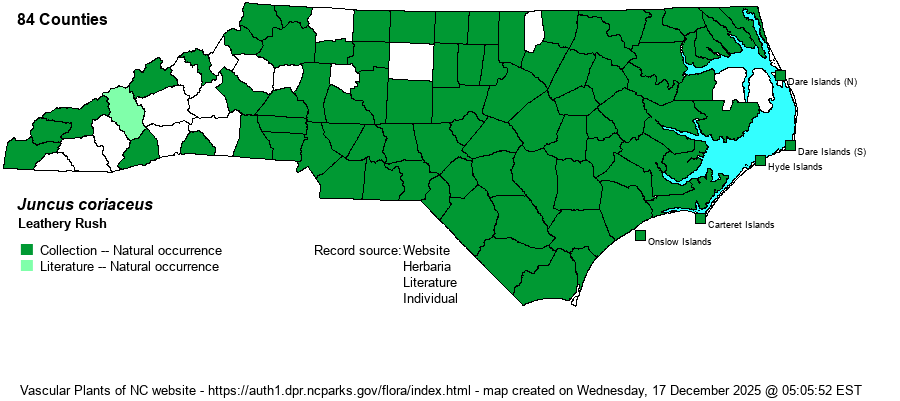| Author | Mackenzie | |
| Distribution | Nearly throughout the state, but relatively sparse in the Mountains.
Coastal Plain, southern NJ to central FL and eastern TX; inland provinces to OK, AR, TN, KY. | |
| Abundance | Frequent to common, except in the Mountains where uncommon. | |
| Habitat | Moist to wet marshes, impoundment margins, maritime swamp forests, maritime shrub swamps, Longleaf Pine savanna-shrub pocosin ecotones, roadside ditches, moist to wet forest clearings. |
| Phenology | Flowering and fruiting June-September. | |
| Identification | Leathery Rush is much like the ubiquitous Soft Rush (J. effusus) in having the inflorescence appear to be lateral and well below the tip of the stem. However, the inflorescence is smaller and fewer-flowered, the capsules are more rounded (vs. subglobose at most), and the stems narrower and not as soft. | |
| Taxonomic Comments | None
NOTE on Juncus: These "grasslike" or "sedgelike" plants occur in most habitats, especially where moist or wet. They can immediately be told from grasses and sedges by the presence of 6 tepals (petal-like) that surround the fruit. These tepals can be thought of as analogous to sepals and petals of, say, lilies or trilliums. Most species have brown, chestnut, or reddish tepals and dark brown fruits. The flowers occur in few- to many-flowered heads. Leaves are nearly all basal and round in cross-section. Stems are unbranched, except for the inflorescence. Fruits are termed capsules and contain many tiny seeds. | |
| Other Common Name(s) | None | |
| State Rank | S5 | |
| Global Rank | G5 | |
| State Status | | |
| US Status | | |
| USACE-agcp | FACW link |
| USACE-emp | FACW link |

